CAA News Today
CAA Members among the 2017–18 Rome Prize Winners
posted by CAA — April 28, 2017
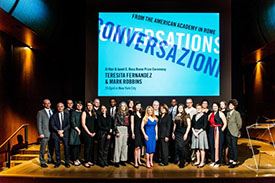 The American Academy in Rome has announced the recipients of its 2017–18 fellowships. The following CAA members are among the newest group of talented artists, scholars, writers, and composers chosen by the academy.
The American Academy in Rome has announced the recipients of its 2017–18 fellowships. The following CAA members are among the newest group of talented artists, scholars, writers, and composers chosen by the academy.
- Charles K. Williams II Rome Prize: Lisa Deleonardis, Austen-Stokes Professor, Department of the History of Art, Johns Hopkins University, “A Transatlantic Response to Worlds That Shake: Jesuit Contributions to Anti-Seismic Building Design in Early Modern Italy and Peru”
- Millicent Mercer Johnsen Post-Doctoral Rome Prize: Bissera V. Pentcheva, Professor, Department of Art History, Stanford University, “Animation in Medieval Art”
- Phyllis W. G. Gordan/Lily Auchincloss/Samuel H. Kress Foundation Pre-Doctoral Rome Prize: Joseph Williams, PhD Candidate, Department of Art, Art History, and Visual Studies, Duke University, “The Practice and Production of Architecture during the Mediterranean Commercial Revolution: The Church of S. Corrado in Moletta (ca. 1185–1303)”
- Andrew W. Mellon Foundation/National Endowment for the Humanities Post-Doctoral Rome Prize: Leslie Cozzi, Curatorial Associate, Hammer Museum, “Fra: Relation and Collaboration in Contemporary Italian Art”
- American Academy in Rome—Rome Prize: Cécile Fromont, Assistant Professor, Department of Art History, University of Chicago, “Images on a Mission: Cross-Cultural Encounters and Visual Mediation in Early Modern Kongo and Angola”
For over a century, the American Academy in Rome has awarded the Rome Prize to support innovative and cross-disciplinary work in the arts and humanities. Rome Prize fellowships include a stipend, room and board, and an individual work space at the institute’s eleven-acre campus in Rome.
New in caa.reviews
posted by CAA — April 28, 2017
Alise Tifentale reviews Anri Sala: Answer Me, an exhibition and catalogue organized by the New Museum. As the Albanian artist’s “first comprehensive survey exhibition in the United States,” the show primarily features video and sound works and “introduces Sala’s artistic strategies that often are aimed at multisensory confusion and a questioning of temporal and spatial coherence.” Read the full review at caa.reviews.
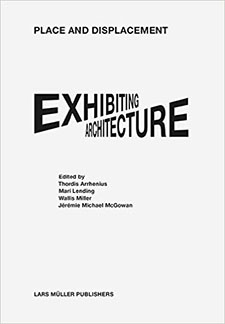 Nikolas Drosos reads Place and Displacement: Exhibiting Architecture, an edited collection of fifteen essays. Focusing on “the institutional structures that underpin architectural practice, theoretical discourse and its dissemination, as well as architecture’s relationship to its publics and to mass media,” the volume “reflects a greater tendency in scholarship to focus less on individual buildings.” Read the full review at caa.reviews.
Nikolas Drosos reads Place and Displacement: Exhibiting Architecture, an edited collection of fifteen essays. Focusing on “the institutional structures that underpin architectural practice, theoretical discourse and its dissemination, as well as architecture’s relationship to its publics and to mass media,” the volume “reflects a greater tendency in scholarship to focus less on individual buildings.” Read the full review at caa.reviews.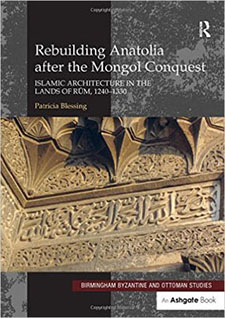 Christiana Maranci discusses Rebuilding Anatolia after the Mongol Conquest: Islamic Architecture in the Lands of Rūm by Patricia Blessing. The author “emphasizes the local circumstances in which the monuments were produced” and “argues that the lack of centralized control in Anatolia led … to a diverse and dynamic tradition best understood on its own terms.” Read the full review at caa.reviews.
Christiana Maranci discusses Rebuilding Anatolia after the Mongol Conquest: Islamic Architecture in the Lands of Rūm by Patricia Blessing. The author “emphasizes the local circumstances in which the monuments were produced” and “argues that the lack of centralized control in Anatolia led … to a diverse and dynamic tradition best understood on its own terms.” Read the full review at caa.reviews.
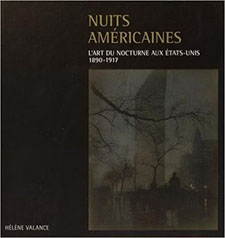 William Sharpe examines Hélène Valance’s Nuits américaines: L’art du nocturne aux États-Unis, 1890–1917. This “much-needed history” shows “how image makers reacted to the ways in which the American night was lit, exploited, and commercialized from the turn of the twentieth-century until the U.S. entry into World War I,” often in relation to “aesthetic, racial, imperial, and economic interests.” Read the full review at caa.reviews.
William Sharpe examines Hélène Valance’s Nuits américaines: L’art du nocturne aux États-Unis, 1890–1917. This “much-needed history” shows “how image makers reacted to the ways in which the American night was lit, exploited, and commercialized from the turn of the twentieth-century until the U.S. entry into World War I,” often in relation to “aesthetic, racial, imperial, and economic interests.” Read the full review at caa.reviews.Communing with Dore Ashton
posted by CAA — April 28, 2017
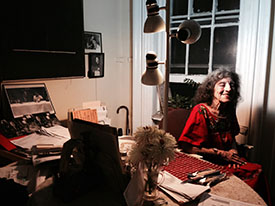
Dore Ashton at the kitchen table in her home on East Eleventh Street, New York, New York, 2011 (photograph © Madeline Djerejian)
“Communing with Dore Ashton” by Michael Corris has just been published at the open-access Art Journal Open. Corris, an artist and author based in Dallas, writes that Ashton, who died on January 30, was “one of the most energetic, widely published, and politicized American writers on art, and one of the chief proponents of the artists of the New York School (she decried the label Abstract Expressionism).” In addition to Corris’s personal memories of Ashton and their friendship, the project includes the audio and transcribed text of their 2011 conversation about Ashton’s experiences in New York art world during the 1950s and 1960s. Also included is a 2015 film by the artist Alfredo Jaar, Dore Ashton, you know, which features Ashton speaking candidly about her life, writing career, politics, and relationships with artists and writers, among them Harold Rosenberg, Philip Guston, and Louise Bourgeois. Recent photographs by Madeline Djerejian and Polly Bradford-Corris portray Ashton in her working and living spaces in New York City and Springs, Long Island.
Letter from Melbourne: An Exhibition at the Victorian College of the Arts Tackles Contested Lands and Landscape
posted by Sean Lowry, Head of Critical and Theoretical Studies,Victorian College of the Arts, University of Melbourne, Australia — April 27, 2017
We live in a world in which deeply contested perceptions of time and place coexist on lands shared by diverse populations. The unresolved politics of land that confront Indigenous cultures in Australia are a prime example of how such contestations continue to play out in a postcolonial context. Such tensions are particularly apparent when contrasting radically divergent artistic and historical representations of landscape. Australia is a vast and ancient continental landmass upon which a little over two centuries of colonization has savagely interrupted 50,000 years of continuous human culture expressed through over 500 distinct collective nominations. Presence, an ambitious exhibition curated by David Sequeira in the Margaret Lawrence Gallery at the Victorian College of the Arts (VCA), University of Melbourne (March 3–April 1, 2017), entered this seemingly inexpressible contestation with a curatorial strategy that provisionally marked out something of the possibility of aggregating these radically disparate understandings. As this text will attempt to demonstrate, Sequeira, in bringing otherwise ineffably distinct representations of the Australian landscape together, implicitly suggested that violently incompatible senses of time and place might indeed share space—and possibly even begin to communicate with one another.

Figures 1 and 2 show the gallery installation with Michael Riley’s film presented in the center. The two images from the film depict different contemporary perspectives of a land occupied by Indigenous cultures for tens of thousands of years. The smaller paintings installed on the perimeter wall are by well-known Australian artists who are all alumni of the Victorian College of the Arts upon the occasion of its 150-year celebration (see Figures 3–8 below).
Upon entering the dramatically darkened gallery, the viewer encountered a series of small uncaptioned spot-lit paintings by some of the VCA’s most distinguished alumni. These works appeared to be floating like a constellation of celestial objects around a large moving image projection at the center of the exhibition space. Sequeira strategically positioned Empire, a film by the late Indigenous Australian artist Michael Riley, at the heart of this carefully considered installation of historical and contemporary landscape paintings.

Figure 3: Eugene Von Guérard, From below the Lighthouse, Cape Shanck, Victoria, 1873, oil on paper on board, 9.7 x 12.4 in. (photograph provided by the Wilbow Collection)
Figure 4: Frederick McCubbin, At Macedon, 1913, oil on canvas 20.4 x 24.1 in. (photograph provided by the Wilbow Collection)
Figure 5: Fred Williams, Hillside III, 1968, oil on canvas, 24 x 26 in. (photograph provided by the Heidi Victoria Collection)
Contextualizing work by Eugene Von Guerard, Frederic McCubbin, Fred Williams, Clarice Beckett, Louise Hearman, and Rick Amor with that of Riley, Sequeira seductively stipulated that the viewer become mindful of Indigenous understandings of landscape that existed for 50,000 years prior to the VCA’s own 150-year history.

Figure 6: Clarice Beckett, Half Moon Bay, undated, oil on board, 11.2 x 15 in. (photograph provided by Rosalind Hollinrake and Niagara Galleries)
Figure 7: Louise Hearman, Untitled #480, 1997, undated, oil on composition board, 27 x 21 in. (photograph provided by the Wilbow Collection)
Figure 8: Rick Amor, Summer Morning Lucerne Crescent Alphington, 2012, oil on canvas, 20.1 x 15.9 in., Courtesy the artist and Niagara Galleries.
Not inconsequentially, Riley was not a VCA alumnus. This was a brave and deliberate curatorial gesture on the part of Sequeira to mark the occasion of the institution’s 150-year celebrations: “For most of its 150-year history, the Victorian College of the Arts ignored Indigenous Australian culture and art practices. I wanted the large-scale projection (including its soundtrack) by Indigenous artist Michael Riley to be the filter through which the other works of art are perceived.”[1]
Significantly, the deliberately modestly sized selection of paintings orbiting Riley’s intermittently expansive and forensic visual meditation upon the impact of colonialism and Christian missionary activities on Australian Aboriginal land and culture, were subsequently drawn inward to perform in concert with the deeply melancholic musical score by composer Antony Partos and performed by the Tasmanian Symphony Orchestra that accompanied Riley’s filmic essay. Sound is clearly an important part of Sequeira’s matrix of considerations. Considered together with the lighting design, we can see why Sequeira describes a “multi-sensory approach” as “critical in the process of generating new [historical] resonances.” Already an ode to the simultaneous expansiveness and minutiae of Australian landscape, once experienced on a big screen at the center of Sequeira’s installation, Empire commanded a hitherto unconsummated presence (especially when considered in comparison with earlier broadcast and exhibition presentations).
It was clear that none of these works had ever been exhibited like this before. Consequently, one of the most marked features of this exhibition was the conspicuous visibility of Sequeira’s curatorial voice. Moreover, it was not a stretch to reimagine this poetic exploration of new possibilities in selection and display as an installation by an artist rather than the work of a curator. Here, networks of relations marked between very different artistic materializations and senses of placemaking clearly instantiated the space of the exhibition itself as medium. In demonstrating profound new ways in which very different conceptions of landscape might sing together, and by extension, how accepted lineages of art history might in turn learn to incorporate understandings of Indigenous Australian art and culture, Sequeira created a work of art that far exceeded a sum of its parts. Although Sequeira understands his responsibilities to these histories “as part of a bigger commitment as an artist,” he also recognizes that curatorship demands very particular responsibilities. Despite the fact that we might reimagine the exhibition as an installation by Sequeira the artist, Sequeira the curator nevertheless understood that this would invariably “reflect a different style of authorship.” Interestingly, he appeared at once emboldened and troubled when asked to consider the exhibition as an installation by him as an artist. Clearly, Sequeira necessitates that these activities remain ontologically separate—for as Ruth Noack put it in 2015—just as “the other of the artist as curator is the curator,” it is also apparent that “the other of the curator as artist is the artist.”[2]
Importantly, Sequeira sees his “own subjectivity is a departure point for the exploration of other histories.” As a “middle-aged gay Indian born Australian man,” he sees his “subjectivity as an access to the disclosure of new understandings of art and art history.” For Sequeira, “creating opportunities for the revelation of new or previously undistinguished facets of history is integral to this process.” In order to facilitate this process, he first considers “selection and display strategies used in the construction mainstream histories” and then begins to develop alternative formats that suggest “new resonances within both individual works of art and a group as a whole.” When asked to imagine this exhibition as the first in a series, and that its next instantiation might be in the United States, Sequeira excitedly described one possible scenario:
the compelling video work of Mohawk artist Alan Michelson could be a potent context for re thinking American landscape painting. For example, set within a suite of small historic and contemporary landscape paintings by artists such as Thomas Cole, Josephine Chamberlin Ellis, Frederick Church, Georgia O’Keefe [sic], Alma Thomas, Andrew Wyeth, Michelson’s large scale projection (on a screen of turkey feathers), Mesprat, 2001 could expand the understandings of consumerism, spirituality, the sublime, environmentalism and ownership associated with considerations of landscape.
From exhibitions to nation states, delineations of place are destined to be dynamic and temporary. Unlike space, which possesses abstract physical and formal properties, the value of place is socially constructed. Against a backdrop of inevitable change, art performs both a mnemonic and a transitive role. This role is perhaps most apparent when art is experienced as a dynamic constellation of elements rather than as ossified objects. Although the idea of landscape is central to the sense of being in Australia, it can clearly evoke complex and unresolved historical and political tensions. Artists that deal with landscape as subject are by default connected to these tensions. The island continent of Australia is at once a timeless geological formation and a historically layered series of cultural projections. For a mere blip in historical time, a new nation has been superimposed over an ancient geological formation and accompanying appropriated nations. Landscape, like painting, is a register of gestures enacted upon a surface. Marks, together with conspicuous omissions and evacuations, can imply both desolation and new possibilities. Painting, like film, is a fertile ground upon which to stage a dynamic play between registers of information and space for the imagination to flourish. By suggesting new possibilities through the poetic play of disparate representations of landscape, and at the same time reminding the viewer that full comprehension is impossible, Sequeira has created an evocative vehicle with which to reimagine absence and presence.
[1] David Sequeira, email conversation with the author, March 31, 2017. All subsequent quotations by Sequeira are from email conversations that took place between March 31 and April 3, 2017.
[2] Ruth Noack, “The Curator as Artist?” (symposium presentation, Central Saint Martins, London, November 10, 2012). See http://afterall.org/online/artist-as-curator-symposium-curator-as-artist-by-ruth-noack/.
News from the Art and Academic Worlds
posted by Christopher Howard — April 26, 2017
Each week CAA News summarizes eight articles, published around the web, that CAA members may find interesting and useful in their professional and creative lives.
A Letter to Soon-to-Be Art School Graduates
You’re about to begin your career as artists. At this defining moment of transition, I’d like to offer five pieces of advice that I wish someone had shared with me when I graduated art school. (Read more from CERF+.)
Help Desk: Recommendations for References
I am often torn when applying for jobs, residencies, and grants when it comes to references. Is it better to list the names of people you do not know well but carry more name recognition, or to list the names of lesser-known people you know well and would give you a good reference? (Read more from Daily Serving.)
How Galleries Support Their Artists
Galleries have multiple roles, both visible and invisible: to incubate and support their artists, often by going above and beyond the normal work of putting on shows, promoting their artists, and selling the works; and to providing services such as financial management or book publishing, to help their artists focus more fully on their work. (Read more from Artsy.)
Group Shows Bring Together Works by Black Women Artists
Nearly forty years ago, CAA’s National Women’s Caucus for Art planned an exhibition featuring works by “Afro-American” women artists. Cocurated by Emily Martin and Tritobia Benjamin of Howard University, the show was to be presented at the 1979 Annual Conference in Washington, DC. (Read more from Culture Type.)
The Kids Are Right
Is it inherently misguided to suggest some speech ought to be restricted not by law but by informal rules? Is the space in the discourse that liberalism has granted to bigots emboldened by the Trump era a real problem or not? (Read more from Slate.)
Critique vs. Harassment
The visual arts sometimes involve painful critiques of student work, but the University of Central Florida has warned a well-known professor that he crossed the line into harassment with some salty comments allegedly directed at a female student in an advanced painting class. (Read more from Inside Higher Ed.)
To Depoliticize Art, Trump Has to Do More Than End Federal Endowments
Shut up and go fund yourself. That’s President Trump’s message to arts organizations in his proposal for eliminating the NEA and NEH. CAA is not amused. Declaring “complete and total opposition” to the proposal, it offers toolkits to members to arm them for a fight. (Read more from the Federalist.)
Congressman to Appeal Removal of Art Showing Cops as Pigs, Citing Free Speech
A Missouri congressman is appealing a judge’s ruling in a long-simmering dispute involving a 19-year-old’s painting that shows policemen as pigs. The work was on display at the US Capitol as part of a student art competition and has outraged Republican Congressmen and the conservative media, who have branded the work “anti-police.” (Read more from Artnet News.)
Art Professors of America Interview
posted by Christopher Howard — April 25, 2017
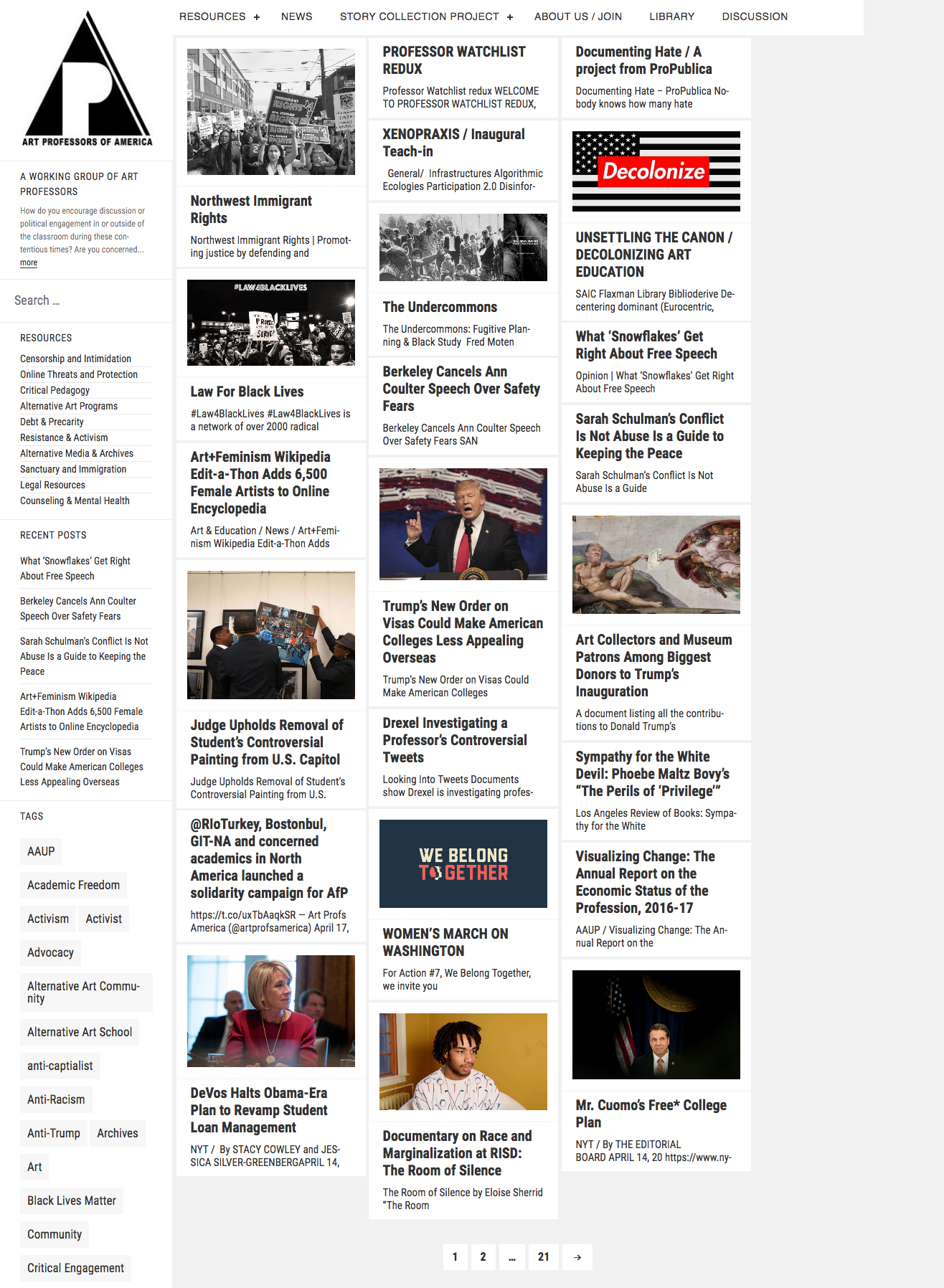 CAA recently corresponded with Marc Handelman, an artist and assistant professor of visual arts for the Mason Gross School of the Arts at Rutgers University in New Brunswick, New Jersey, about a new grassroots organization concerned with advocacy issues, called the Art Professors of America.
CAA recently corresponded with Marc Handelman, an artist and assistant professor of visual arts for the Mason Gross School of the Arts at Rutgers University in New Brunswick, New Jersey, about a new grassroots organization concerned with advocacy issues, called the Art Professors of America.
When and why did the Art Professors of America form? What are its goals?
A couple of dozen art professors from several schools in the Northeast came together in the wake of the election initially to discuss how we might respond to a right-wing campaign to blacklist liberal and progressive faculty by smearing them as un-American. Simultaneously, many of us were seeing a troubling uptick both of threats and attacks on Latino, Muslim, and LGBTQ students, and of anti-Semitism on campuses. Some of us were also experiencing increased feelings of anxiety and self-censorship. Most of all, we felt the urgency and need of being together and sharing our experiences as artists and educators and citizens. We decided to meet every two weeks in New York and continue the conversation. Because colleagues from around the country reached out to be part of the dialogue, we started an email group that now represents professors in well over a dozen states. We are currently working on expanding this network to all fifty states, welcoming art professors of all ranks and teaching status, including TAs and those between positions. Our primary goal right now is to be a platform that connects people nationally and shares critical information. Our latest project was the launch of our website that features news related to education in our political climate and a critical resource page.
What is the purpose of the advocacy resource APA is building?
There are many potential and actual threats that faculty are facing increasingly. Some of these issues begin at the state level, where funding for classes or entire programs are being cut due to their political content. Other issues range from online harassment to deceptively progressive legislation for free-speech protection on campus. Meanwhile, higher education in general continues to foster crippling student debt as institutions struggle to deal with increasing demands for greater diversity, inclusion, and equity. The resource page we launched and continue to build on modestly attempts to provide critical information and tools to help us deal with some of these problems, from distributing information about student loans for undocumented students to debt models in art education. Other items provide online security protocol and consent laws for recording in classrooms. Some of the categories include Censorship and Intimidation, Critical Pedagogy, Alternative Art Programs, Debt and Precarity, Sanctuary and Immigration, and Legal Resources, among others.
Where do the resources come from?
Nearly all of the content already exists online in some form, from other organizations and studies. Populating the website was an extensive three-month process of collecting information and links and aggregating them in these categories. We have been so grateful to other working groups and colleagues for sharing their resources as well.
What are the most urgent issues confronting art professors in the United States today?
Clearly we don’t assume to speak for every program. But in the immediate context, the travel ban and ICE deportations may have the most immediate effects on our students, faculty, and visiting artists. Academic freedom has been under various levels of threat for a long time, and it remains to be seen how deeply and broadly new threats develop. But economic precarity and inequality remain the most pressing structural issue in education both for art schools and the larger university system. This affects part-time adjuncts who, already underpaid, are increasingly asked to do things such as decrease their course loads so as not to trigger contingent benefits, the end of tenured lines, and students who suffer under crippling debt or have no access to higher education at all. Critical and progressive curricula can’t make up for the undergirded issues of access, which are directly tied to geography, race, and class.
Under this current political regime, arts faculty may actually have a greater deal of security than professors and departments researching and teaching social justice, antiracism, and climate change. We need to continually find ways to support our colleagues in other fields.
How can CAA members get involved?
We welcome new arts-affiliated adjuncts, TAs, and professors into our organization and dialogue—the more voices represented, the better. Members will have access to group documents and files, as well as The Story Collection Project, which shares and archives testimonials and stories about what is happening in different corners of our campuses and in classrooms across the country. Meanwhile, the Art Profs America website, offering news, links, and resources, is live and available to anyone online. Please feel free to share with other colleagues as well. You can visit us, or join at http://artprofsamerica.com.
To request to join the discussion, please visit https://groups.google.com/d/forum/art-profs-america. You may also follow APA on Twitter.
Staff Interview: Fernando Zelaya
posted by CAA — April 24, 2017
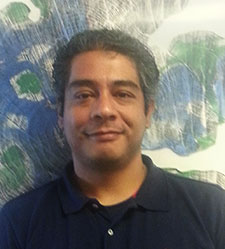 The next in a series of interviews with staff members is a conversation with Fernando Zelaya, CAA controller.
The next in a series of interviews with staff members is a conversation with Fernando Zelaya, CAA controller.
How long have you worked at CAA?
I have been at CAA since December 2012—four years, four months.
What do you do at CAA?
I am the controller, in the Finance Department.
What does CAA mean to you?
CAA to me is a medium for all art scholars to come together and be a part of a community. It’s also a place to share with each other, and to teach each other.
Can you talk about one of your favorite member moments?
Since I interact with members mostly at the conference, I’ll tell one story here and add another in the conference question later on. My favorite member moment was when I helped an elderly member who reminded me of my grandmother. She had such vigor and enthusiasm and seemed genuinely happy to be at the conference. That made my day.
What do you like best about the arts and working in the arts?
What I like best is meeting and working with artists. In my daily life and my earlier years, I had never interacted with artists. Now, having worked for the Dia Art Foundation as well as CAA, I have learned to appreciate art more than I used to, because now I better understand the meaning behind the art.
Do you have a favorite moment from the Annual Conference?
Once at registration I was berated by a flustered member who was late to a session and wanted to get his ticket quicker than was possible. The nice moment came when he returned to my booth after the session was over and gave me a sincere apology.
People interested in art can sometimes rebuff things like sports. But you’re interested in sports like soccer and baseball. Do you see a conflict?
I think that art and sports have more in common than people think. Both require years of hard work to perfect, and both need a combination of grace and power to achieve the objective of the piece (in art) or to score (in a game). It takes grace to stop a soccer ball or save a shot coming toward you at fifty to sixty miles per hour, or to hit a baseball with a bat when both objects are about three inches wide. That kind of skill, to me, is just as beautiful as a stroke of a brush or a poem that can draw a tear or bring about a smile.
You’re also interested in science fiction. Are there any new television shows or movies that have piqued your interest?
Science fiction is my favorite type of television show or movie. My favorite is Doctor Who, because of its sheer brilliance and how it has evolved over the last fifty-three years. The series even survived being off the air, only living in print and audio for almost ten years. The best new show I have seen this year is The Man in the High Castle, which takes us to a world where the Axis powers won WWII and have divided the United States among them. I am also a big fan of the Marvel and DC movies. I love these types of shows or movies because it is fun to immerse myself for a couple of hours—okay, maybe more than a couple—and go somewhere magical or even quite insane.
New in caa.reviews
posted by CAA — April 21, 2017
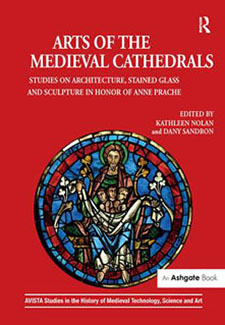 Evelyn Staudinger reviews Arts of the Medieval Cathedrals: Studies on Architecture, Stained Glass and Sculpture in Honor of Anne Prache, edited by Kathleen Nolan and Dany Sandron. The essays “honor the Sorbonne professor’s rich contributions to medieval art and architecture.” Covering a wide variety of topics, “the editors and authors have done a fine job celebrating Prache’s great intellectual acumen, diplomatic gifts, and warmth as a human being, while leaving behind erudite ‘memories’ and a wealth of new ideas.” Read the full review at caa.reviews.
Evelyn Staudinger reviews Arts of the Medieval Cathedrals: Studies on Architecture, Stained Glass and Sculpture in Honor of Anne Prache, edited by Kathleen Nolan and Dany Sandron. The essays “honor the Sorbonne professor’s rich contributions to medieval art and architecture.” Covering a wide variety of topics, “the editors and authors have done a fine job celebrating Prache’s great intellectual acumen, diplomatic gifts, and warmth as a human being, while leaving behind erudite ‘memories’ and a wealth of new ideas.” Read the full review at caa.reviews.
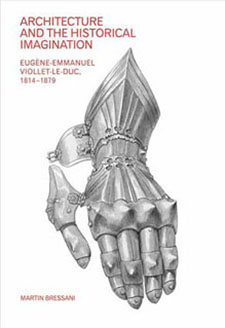 Jessica Basciano examines Architecture and the Historical Imagination: Eugène-Emmanuel Viollet-le-Duc, 1814–1879 by Martin Bressani. Viollet-le-Duc is “the nineteenth-century French architect, restorer, and theorist whose numerous and diverse activities continue to enthrall and perplex historians.” Although the “book’s complex arguments could be made clearer by offering more straightforward exposition,” “Bressani’s intellectual biography stands out in the landscape of Viollet-le-Duc studies because it offers a unified narrative based on the distinctive premise that the architect was motivated consistently by a form of pathological mourning.” Read the full review at caa.reviews.
Jessica Basciano examines Architecture and the Historical Imagination: Eugène-Emmanuel Viollet-le-Duc, 1814–1879 by Martin Bressani. Viollet-le-Duc is “the nineteenth-century French architect, restorer, and theorist whose numerous and diverse activities continue to enthrall and perplex historians.” Although the “book’s complex arguments could be made clearer by offering more straightforward exposition,” “Bressani’s intellectual biography stands out in the landscape of Viollet-le-Duc studies because it offers a unified narrative based on the distinctive premise that the architect was motivated consistently by a form of pathological mourning.” Read the full review at caa.reviews.
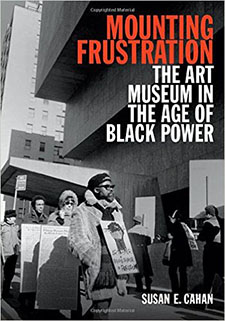 Anne Monahan reads Mounting Frustration: The Art Museum in the Age of Black Power by Susan E. Cahan. Framing her review with a discussion of recent police shootings of unarmed African American males and subsequent artists’ responses, Monahan presents Cahan’s “finely grained history of the New York art establishment’s attempts circa 1970 to reckon with African American representation.” Utilizing “close readings of archival documents, interviews, and secondary sources,” Cahan shows how demands by activists “conditioned the museums’ exhibition and hiring practices for decades thereafter.” Read the full review at caa.reviews.
Anne Monahan reads Mounting Frustration: The Art Museum in the Age of Black Power by Susan E. Cahan. Framing her review with a discussion of recent police shootings of unarmed African American males and subsequent artists’ responses, Monahan presents Cahan’s “finely grained history of the New York art establishment’s attempts circa 1970 to reckon with African American representation.” Utilizing “close readings of archival documents, interviews, and secondary sources,” Cahan shows how demands by activists “conditioned the museums’ exhibition and hiring practices for decades thereafter.” Read the full review at caa.reviews.
Presentation on Fair Use at UCLA
posted by CAA — April 19, 2017
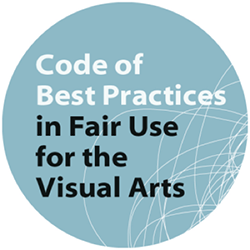
CAA is hosting “Fair Use and the Visual Arts,” a presentation and panel discussion led by Peter Jaszi, Professor, Washington College of Law, American University, on Friday, May 5, 2017. The event will focus on the College Art Association’s Code of Best Practices in Fair Use for the Visual Arts and will take place at the UCLA Library from 10:00 AM to 2:00 PM. Lunch will be served.
Come join the conversation! Please RSVP to give us your lunch preferences, and when you do, please share your specific Fair Use questions so our presenters can break it down for you.
For more information: https://www.library.ucla.edu/events/code-best-practices-fair-use-visual-arts.
This event is made possible by a grant from the Andrew W. Mellon Foundation.
News from the Art and Academic Worlds
posted by Christopher Howard — April 19, 2017
Each week CAA News summarizes eight articles, published around the web, that CAA members may find interesting and useful in their professional and creative lives.
The More Things Change
Pay for full-time faculty members rose 2.6 percent this academic year over last, according to “Visualizing Change,” the American Association of University Professors’ Annual Report on the Economic Status of the Profession. But professors shouldn’t get too excited: adjusted for inflation, that amounts to just 0.5 percent. (Read more from Inside Higher Ed.)
A New Site Is Helping High-Quality Creatives Find Work—and Get Paid
Easle is a freshly launched online platform that aims to connect high-quality creatives with reliable clients across the globe. Through an algorithm, the site helps match creatives with jobs that are well suited to their skills and then facilitates the logistics of paperwork and payment. (Read more from Artsy.)
A Syllabus for Making Work about Race as a White Artist in America
Many white-identified students, artists, and art workers feel stuck in that racial construct. They are nervous to tread into any conversation about race and avoid the question. But what about those who identify as white and still want to make works rich with social and historical narrative? (Read more from Hyperallergic.)
Donated Slides from the Met Get a Second Life
It is definitely a digital-age question: What to do with old-fashioned color slides of all-but-forgotten visits to see Grandma or department store Santas? Year after year, they lie in their boxes on a shelf, no longer looked at. The Metropolitan Museum of Art faced the same question on a much larger scale. It had thousands of 35mm slides, showing everything from close-ups of Manets and Monets to wide-angle shots of the galleries. (Read more from the New York Times.)
Designed for Social Change
Though “spatial justice” is often thought of as an enterprise in the public realm, like the construction of parks and community centers, it’s not as frequently addressed in the private realm. Because housing is essential to well-being, the architect Dana McKinney hopes to eventually create spaces that promote not just equality, but equity. (Read more from the Harvard Gazette.)
Bringing Respect to the Craft Artist
Giving lesser-known artists visibility is key to the mission of the Craft and Folk Art Museum, says executive director Suzanne Isken, whose institution has an annual operating budget of about $730,000. Which is why a $25,000 grant from the NEA has been so crucial for the Los Angeles museum to stage its current exhibition, Chapters: Book Arts in Southern California. (Read more from the Los Angeles Times.)
Publishers and Open-Resource Advocates Square Off on the Future of Course Content
At a friendly yet spirited debate last month over the pros and cons of open educational resources, publishers and open-access advocates agreed on at least one thing—the “old” textbook market is broken. But that’s pretty much where the common ground ended. (Read more from the Chronicle of Higher Education.)
Pedagogic Approaches to Teaching with Art in the Sciences
When dealing with courses in the hard and life sciences, we approach engagement with art differently. Founded on the types of interactions with the collection that STEM faculty tend to request and on the recent pedagogic emphasis on active, inquiry-based learning that also touches on the creative aspects of science, we distinguish four kinds of interactions with art: skill-building, thematic, problem-based, and dispositional. (Read more from Art History Teaching Resources.)


